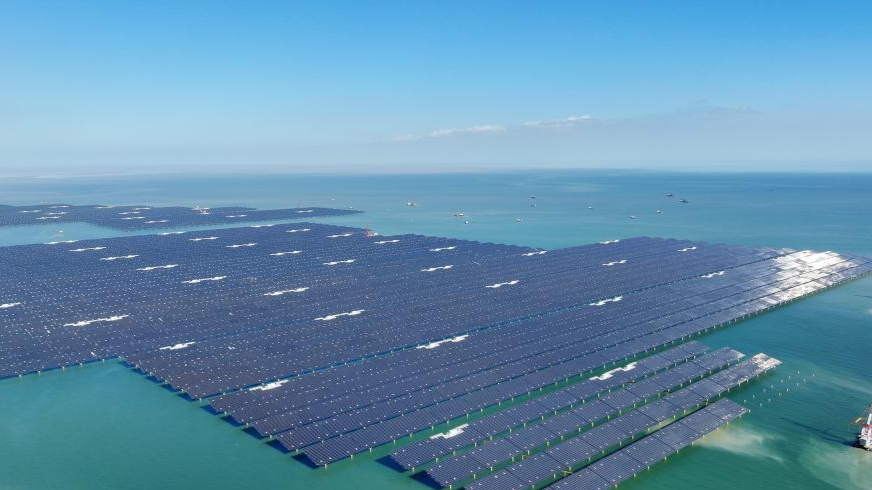Chinese scientists decipher mystery of sticky soil on moon's far side
BEIJING, Nov. 24 (Xinhua) -- Chinese scientists have unraveled the mystery behind the unusually cohesive lunar soil retrieved by China's Chang'e-6 mission from the far side of the moon.
The soil's sticky and clumpy characteristics -- which distinguished it from samples collected on the near side of the moon, had captivated researchers since the mission's successful completion in 2024.
This intriguing observation prompted a comprehensive investigation by a research team led by the Institute of Geology and Geophysics (IGG) under the Chinese Academy of Sciences. Their findings have been published in the latest issue of Nature Astronomy.
To figure out this peculiar feature, the team carried out a series of experiments, including fixed funnel tests and drum tests -- to measure the angle of repose of the Chang'e-6 lunar soil. This angle serves as a key indicator of the flow behavior of granular materials. Results revealed that the Chang'e-6 soil exhibited a significantly higher angle of repose compared to near-side samples, rendering its flow properties more akin to those of cohesive terrestrial soils.
Detailed compositional analyses ruled out magnetic forces or the presence of clay minerals as reasons for the enhanced cohesion. Instead, the researchers identified a synergistic interplay of three interparticle forces -- friction, Van der Waals forces and electrostatic forces. The influence of Van der Waals and electrostatic forces, notably, becomes especially pronounced when the soil particles are finer.
The study pinpointed a critical "particle size threshold" -- when the D60 value, the diameter below which 60 percent of the soil sample's mass consists of smaller particles, falls below approximately 100 micrometers, Van der Waals and electrostatic forces substantially amplify the soil's cohesiveness.
Using high-resolution CT scanning, the team analyzed more than 290,000 individual soil particles from the Chang'e-6 samples. They found that the Chang'e-6 soil had the smallest D60 value, only 48.4 micrometers -- thus indicating significantly finer particles. These particles also displayed more complex shapes and lower sphericity compared to near-side samples.
"This is quite unusual," noted Qi Shengwen, a professor at the IGG. "Typically, finer particles tend to be more spherical. However, the Chang'e-6 soil, despite its finer size -- features more intricate shapes."
The researchers propose that this anomaly may stem from a higher content of easily fractured feldspar minerals, combined with potentially stronger space weathering effects on the lunar far side. The interplay of finer and rougher particles strengthens interparticle forces, resulting in the observed high cohesion.
"This study offers the first systematic explanation for the distinctive cohesive behavior of the Chang'e-6 lunar soil from the perspective of granular mechanics," Qi emphasized.
These insights gained are considered critical for future lunar exploration missions -- particularly in activities such as lunar base construction and in-situ resource utilization, where a thorough understanding of soil properties is indispensable, Qi added.
In 2024, Chang'e-6 made history by bringing 1,935.3 grams of lunar far-side samples back to Earth. These samples were collected from the South Pole-Aitken (SPA) Basin, the largest, deepest and oldest basin on the moon.
Photos
 Promotion week for intangible cultural heritage brands opens in Dali, China's Yunnan
Promotion week for intangible cultural heritage brands opens in Dali, China's Yunnan First batch of wintering black-headed gulls arrive at Lugu Lake in Yunnan
First batch of wintering black-headed gulls arrive at Lugu Lake in Yunnan Highlights of women's doubles of badminton at National Games
Highlights of women's doubles of badminton at National Games China's Shandong develops green energies to advance new energy structure transformation
China's Shandong develops green energies to advance new energy structure transformation
Related Stories
- Chinese "lunar soil bricks" return from space, paving way for construction on moon
- Full moon observed across China
- China employs commercial competition to speed up manned lunar program
- China targets manned moon landing by 2030, outlines testing tasks ahead
- Chinese scientists uncover meteorite remnants in moon soil, providing key clues to solar system evolution
Copyright © 2025 People's Daily Online. All Rights Reserved.





